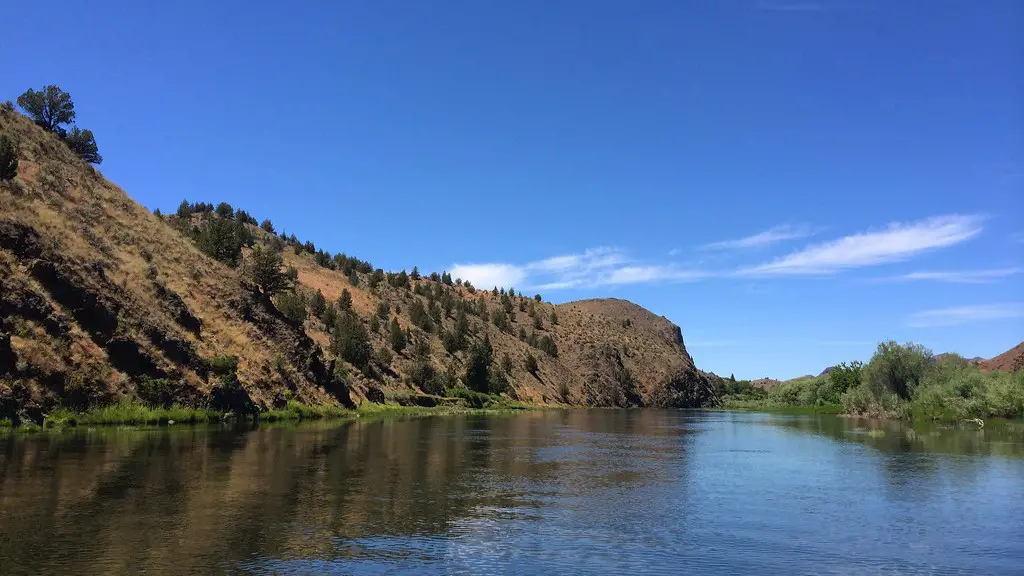Introduction
The Mississippi River has been a part of the United States for nearly 300 years, and its existence and importance in our national history and culture cannot be overstated. This river, often remembered as the lifeblood of the Mississippi Delta and a symbol of the adventurous spirit of the American South, has seen its share of changes throughout the centuries.
The Mississippi River has been subject to frequent flooding, droughts, and changing channels as it travels from its source in Lake Itasca, Minnesota to its mouth at the Gulf of Mexico. Geographers, archaeologists and other experts have used their knowledge of the past to help explain how the Mississippi River has changed over time and the processes that are responsible for these changes.
Current Morphology
Over the centuries, the Mississippi River has shifted its course repeatedly, leading to developments in its morphology – the physical shape and form of the river. In terms of surface area, the river is the fourth-largest in the world. Its length has notably increased over time, due to its general downward course across the United States and its tendency to meander. As it meanders, small creeks, cuts and other changes are made to the landscape, creating a variety of habitats as it goes.
The most defining feature of the Mississippi River is its floodplain. This floodplain – an area of fertile deposited sediment along the course of the river – becomes flooded at various points throughout the year due to fluctuating water levels. The size of the floodplain has grown more expansive in recent years due to deposition of sediment and other debris.
Human Impact
Humans have had a large impact on the Mississippi River. Many of the changes to the river’s morphology have been directly or indirectly caused by human activity. As the population has grown along its course, cities and other human developments have been built close to the river, raising levees and creating dams to control flooding and sediment flow.
As a result, water flow and sediment deposition have been altered, and the landscape along the Mississippi River has changed. Humans have also introduced pollutants into the rivers, leading to an imbalance in the natural ecosystem of the river and its wetland areas.
Climate Change
Climate change is having an increasing effect on the Mississippi River. Rising temperatures have led to increased evaporation and reduced precipitation, leading to dryer riverbeds and increased flooding. This in turn can cause alterations to the morphology of the river, as well as increased sedimentation and the formation of sandbars.
Changes to the climate have also led to a greater frequency of extreme weather events such as hurricanes and tornadoes, which can also cause changes to the river’s course and other alterations to its form. Scientists are still researching the link between climate change and the Mississippi River, and its effects on the surrounding ecosystem.
Environmental Impact
The changing morphology of the Mississippi River has had a dramatic effect on the environment around it. The increased flooding and sedimentation of the river has led to the death of numerous species of plant life and animal life in the surrounding wetlands, as well as an increase in the number of invasive species.
The introduction of pollutants and other toxins into the river has also caused serious damage to the natural environment, resulting in decreased oxygen levels and a decrease in the river’s ability to support a healthy ecosystem. Furthermore, the introduction of non-native species has caused a disruption to the balance of the river’s environment.
Economical Impact
The Mississippi River has long been a source of economic prosperity in the United States, due to its strong presence in the agricultural, industrial and transportation sectors. This prosperity is primarily reliant upon the health of the river, and the changes it experiences can have a dramatic effect on the nearby economies. Floods, for example, can damage roads, bridges and other infrastructure along the river, leading to reduced transportation and shipping times.
In addition, the environmental damage caused by changes to the river’s morphology can reduce the number of habitats for fishing, hunting and other activities. This, in turn, can reduce the number of tourists and visitors to the area, leading to a decrease in local business.
Cultural Impact
The Mississippi River has long been a symbol of the adventurous spirit of the American South, and its presence in popular culture is well established. As its course has changed, so have its cultural impact. The introduction of new species, the rise of commercialization, and the alterations to the natural environment have all shaped how people think of the river.
In recent years, the river has also become a symbol of ecological conservation, as many people are mobilizing to protect its fragile environment. The Mississippi River is an important part of the American identity, and its importance should not be forgotten.
Legal Framework
Because of the importance of the Mississippi River and its effects on the ecosystem, a number of legal measures have been taken to help ensure its preservation and protection. Numerous laws and regulations are in place to protect the various species of wildlife in and around the river, as well as the environment as a whole.
In addition, various land and water rights have been established to help ensure the equitable use of the river by different industries and communities. These rights have helped to ensure that the river is not overused or misused, and have helped to maintain its health.
Conclusion
The Mississippi River is an important part of the American history and identity, and its changes over time have had dramatic effects on the culture, economy and environment of the region. Understanding how the river has changed and the processes that are responsible for these changes is the first step in protecting its future.




